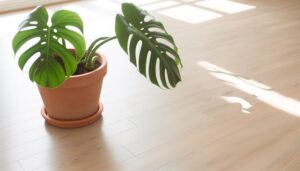How Long Do Monstera Plants Live? Lifespan Secrets Revealed!
Monstera plants, with their strong physiological structures and adaptable growth patterns, can live for decades to over a century when given proper care. Their indeterminate growth habit, efficient nutrient absorption via aerial roots, and large fenestrated leaves maximize light capture for sustained health.
Factors like light exposure, watering practices, humidity, and nutrient availability directly impact longevity. Aim for bright, indirect light and maintain 60-80% humidity to support ideal growth.
Proper watering, pest management, and regular maintenance are essential for prolonging life. To understand the details of ensuring your Monstera thrives for decades, you’ll find detailed insights below.
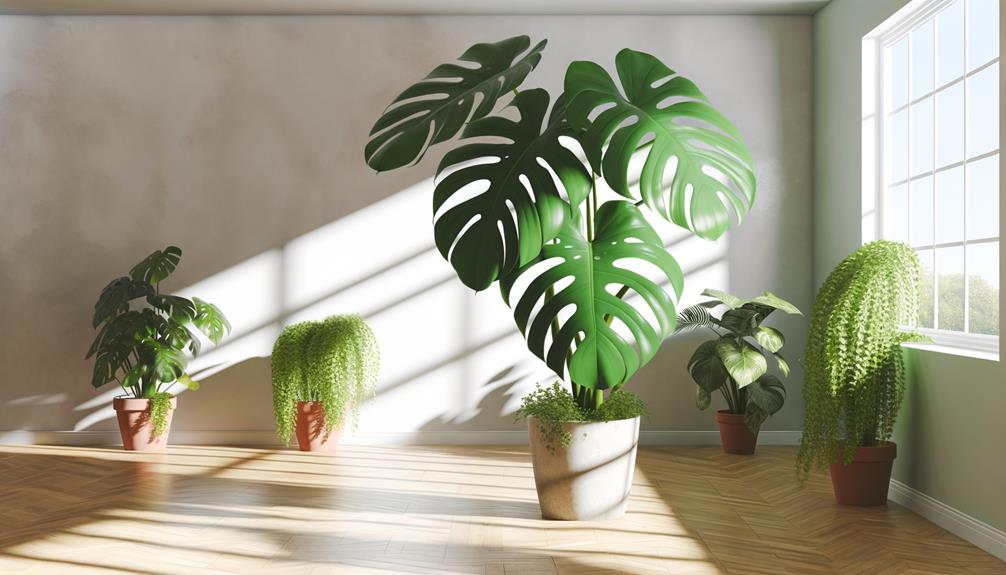
Key Takeaways
- Monstera plants can live for several decades to over a century with proper care.
- Robust physiological structures and adaptive growth patterns contribute to Monstera’s long lifespan.
- Proper care includes bright, indirect light, consistent soil moisture, and high humidity levels.
- Regular monitoring and adjustments of growing conditions prevent stress and promote longevity.
- Healthy Monstera plants continuously produce new leaves and stems, sustaining their vitality.
Average Lifespan of Monstera
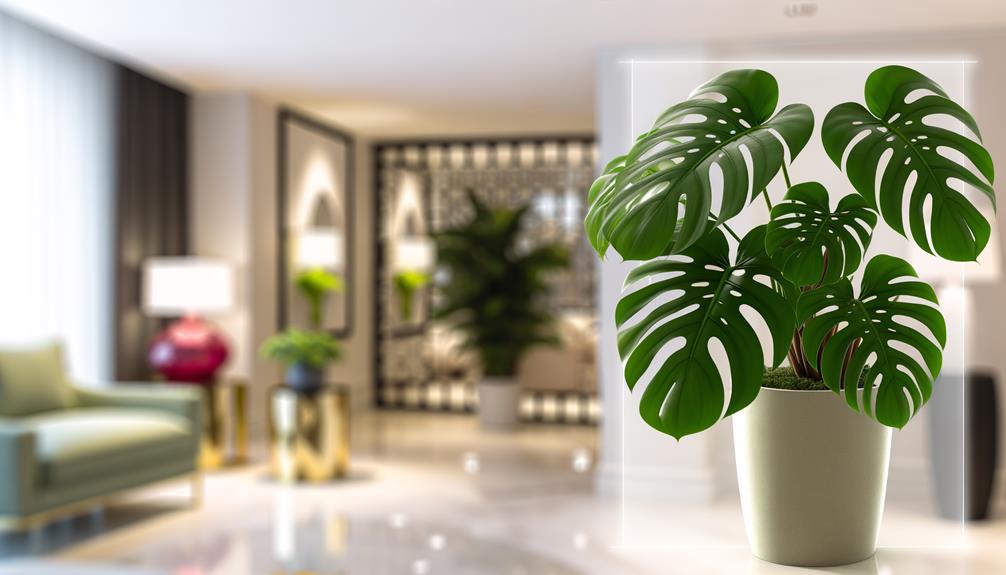
While individual conditions can vary, Monstera plants typically exhibit a lifespan ranging from several decades to over a century when provided with ideal care.
You’ve got to understand that Monstera species, such as Monstera deliciosa, possess remarkable longevity due to their robust physiological structures and adaptive growth patterns. Their aroid nature allows efficient nutrient absorption through aerial roots, enhancing their survival.
The plant’s large fenestrated leaves optimize light capture, essential for photosynthesis. Additionally, their indeterminate growth habit means they continuously produce new leaves and stems, sustaining vitality over time.
Proper care, including adequate watering, humidity, and light, plays an essential role in maximizing their lifespan. With meticulous attention, your Monstera can indeed flourish for generations.
Factors Affecting Longevity
Several critical factors directly influence the longevity of Monstera plants. These include light exposure, watering practices, humidity levels, and nutrient availability.
To guarantee your Monstera thrives, consider the following:
- Light Exposure: Provide indirect, bright light to prevent chlorosis and promote photosynthesis. Avoid direct sunlight, which can cause photodamage.
- Watering Practices: Maintain consistent soil moisture without waterlogging. Overwatering can lead to root rot, while underwatering can cause leaf desiccation.
- Humidity Levels: Aim for relative humidity between 60-80%. Low humidity can result in stomatal closure, impairing the plant’s transpiration and gas exchange processes.
Ideal Growing Conditions
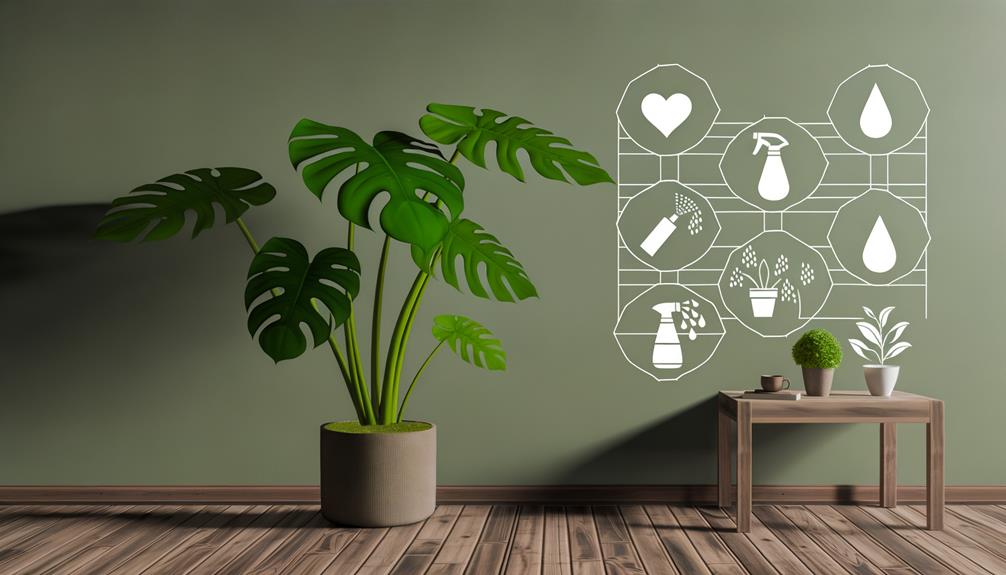
To nurture Monstera plants successfully, you need to carefully balance light exposure, watering frequency, humidity levels, and soil composition.
Monstera plants require bright, indirect light to photosynthesize efficiently without leaf scorch. Aim for a humidity level of 60-80% to mimic their native tropical environment, facilitating prime stomatal function and transpiration.
Use a well-draining, aerated potting mix rich in organic matter to promote robust root development and nutrient absorption. Additionally, maintaining a temperature range between 65°F and 85°F will support metabolic processes and growth.
Regularly monitor these conditions, making necessary adjustments to prevent stress factors that could hinder the plant’s longevity. This holistic approach ensures your Monstera thrives and reaches its full life potential.
Proper Watering Techniques
To optimize your Monstera’s longevity, you must adhere to precise watering frequency guidelines tailored to its growth cycle.
Monitor soil moisture levels using a hygrometer to prevent both dehydration and waterlogging.
Seasonal variations necessitate adjustments in watering practices to accommodate changes in evaporation rates and plant metabolic activity.
Watering Frequency Guidelines
Proper watering techniques are essential for ensuring the health and longevity of your Monstera plant. Both under- and over-watering can lead to serious issues such as root rot or dehydration.
To maintain the best hydration, consider the following guidelines:
- Seasonal Adjustments: In the growing season (spring and summer), water more frequently. During dormancy (fall and winter), reduce the frequency.
- Environmental Factors: Account for humidity, temperature, and light exposure. Higher humidity and lower temperatures generally require less frequent watering.
- Plant Size and Pot Type: Larger plants in smaller pots dry out faster. Porous pots (e.g., terracotta) also lose moisture more quickly than non-porous ones.
Monitoring these variables helps you tailor your watering schedule, promoting robust growth and longevity.
Soil Moisture Levels
Consistently checking soil moisture levels helps you determine the precise watering needs of your Monstera plant, preventing common issues like root rot or dehydration.
Use a soil moisture meter to measure the volumetric water content. Insert the probe into the soil about halfway between the plant’s stem and the pot’s edge. Best moisture levels should range from 45% to 65%.
If you don’t have a meter, insert your finger 2 inches into the soil; it should feel slightly damp, not wet or dry. Overwatering can lead to anaerobic conditions, promoting pathogenic fungi.
Conversely, underwatering stresses the plant, leading to wilting and nutrient deficiencies. By understanding these moisture dynamics, you’ll maintain ideal hydration, ensuring your Monstera’s longevity and health.
Seasonal Water Needs
As the seasons change, adjusting your Monstera’s watering routine to accommodate variations in temperature and humidity is crucial. During winter, when the plant’s metabolic rate decreases, you should water less often to prevent root rot.
Conversely, in summer, increased transpiration requires more frequent watering.
Here’s a detailed approach:
- Winter: Water every 2-3 weeks, ensuring soil is dry up to 2 inches deep.
- Spring/Fall: Water every 1-2 weeks, maintaining consistent soil moisture without waterlogging.
- Summer: Water weekly, ensuring soil remains slightly moist but not saturated.
Common Pests and Diseases
You need to identify common pests like spider mites, scale insects, and thrips, which can severely impact your Monstera’s health. Employing integrated pest management strategies, including biological control and chemical treatments, is essential.
Additionally, understanding how to diagnose and treat plant diseases such as root rot and leaf spot will help maintain your Monstera’s longevity.
Identifying Common Pests
To ensure the longevity of your Monstera plants, it’s important to identify and manage common pests such as spider mites, mealybugs, and thrips, which can cause significant damage if left unchecked.
Spider mites are tiny arachnids that create webbing and suck plant sap, leading to stippled leaves.
Mealybugs, recognizable by their white, cotton-like masses, deplete the plant’s vitality by feeding on its juices.
Thrips are slender insects that scar leaves and flowers by puncturing plant cells and sucking out their contents.
To detect these pests, you should:
- Regularly examine leaves, especially the undersides.
- Watch for signs like discolored spots or webbing.
- Utilize a magnifying glass to observe tiny, moving pests.
Early identification is essential for effective management.
Treating Plant Diseases
Effectively treating plant diseases in Monstera plants involves applying targeted interventions like insecticidal soaps, neem oil, and systemic pesticides to eradicate pests and prevent further damage.
Insecticidal soaps disrupt the cellular integrity of aphids and spider mites, causing dehydration and death.
Neem oil, a broad-spectrum biopesticide, acts by inhibiting feeding and reproduction in pests such as scale and mealybugs.
Systemic pesticides, absorbed by the plant and translocated to all tissues, offer long-lasting protection against a variety of insects and pathogens.
Regularly inspect your Monstera for signs of infestations, such as discolored leaves or sticky residue. Early detection guarantees timely application of treatments, thereby maintaining plant health and prolonging its lifespan.
Always follow manufacturer guidelines for safe and effective use.
Pruning and Maintenance
Regular pruning and maintenance are essential for ensuring the best growth and longevity of Monstera plants. They help manage size, promote healthy foliage, and prevent disease.
Here’s how you can effectively maintain your Monstera:
- Sanitize Tools: Use sterilized pruning shears to prevent pathogen transmission.
- Target Older Leaves: Remove yellowing or damaged leaves to enhance light penetration and nutrient allocation.
- Trim Aerial Roots: Control unruly aerial roots to maintain aesthetic appeal and prevent nutrient diversion.
Propagation Tips
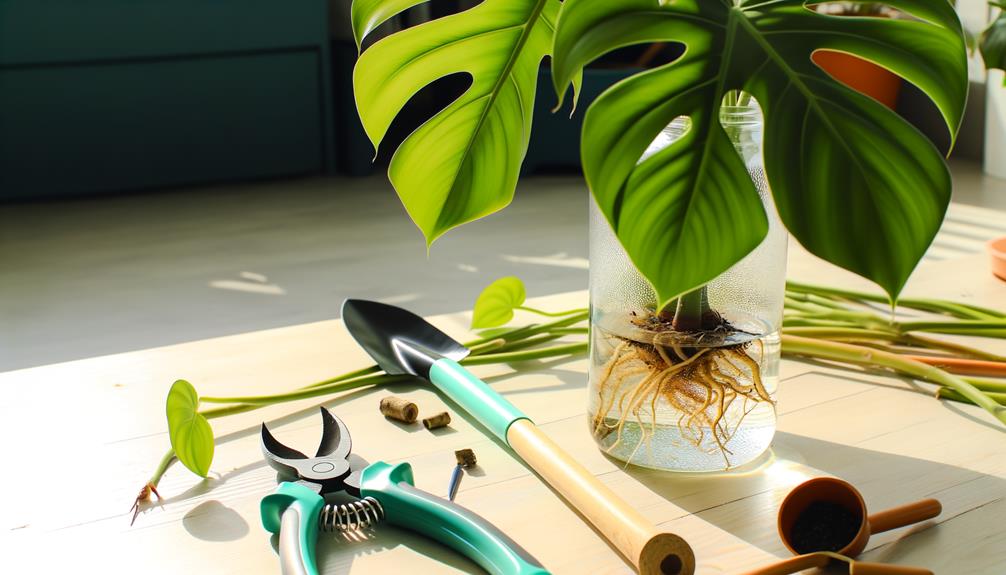
When propagating Monstera plants, begin by selecting a healthy stem with at least one node and a few leaves to maximize the chances of successful root development. Use sterilized pruning shears to make a clean cut just below the node.
Immerse the cut end in water, ensuring the node is submerged but leaves aren’t. Place the container in a bright, indirect light environment. Change the water every few days to prevent bacterial growth. Roots should emerge within 2-4 weeks.
Once roots are 2-3 inches long, transplant the cutting into well-draining potting soil. Maintain consistent moisture levels and avoid direct sunlight to reduce transplant shock. Regularly monitor growth and adjust care routines to support healthy development.
Conclusion
To sum it up, the longevity of your Monstera depends on ideal conditions and attentive care. By ensuring proper watering, perfect light, and vigilant pest control, you can extend its life considerably.
Pruning and propagation aren’t just maintenance tasks; they’re opportunities to rejuvenate your plant. Like clockwork, follow these guidelines, and your Monstera will thrive for decades, becoming a lush symbol of your horticultural skills.


